Coffee is one of the most popular beverages. The love for coffee is deeply ingrained in many cultures around the world. No other beverage is as revered or respected as coffee.
Coffee is one of the most traded commodities. The coffee market generated revenue of US$93.2 billion worldwide in 2024. This market is projected to grow at an annual rate of 4.41% (CAGR 2024-2028).
The aroma of coffee is a universal language of comfort and happiness, uniting people from different cultural backgrounds. Coffee rituals are not limited to morning times; they are a wholesome experience that begins from the moment of the first sip until the last drop.
The industry is constantly evolving, with coffee shops providing specialty coffee menus and F&B beverage manufacturers producing different types of coffee drinks.
With new trends arising every year, F&B manufacturers must explore different coffee drinks to stay ahead of the competition. Therefore, in this post, we will explore 31 different types of coffee to get familiar with them and keep up with the trends.
Coffee Beans Varieties
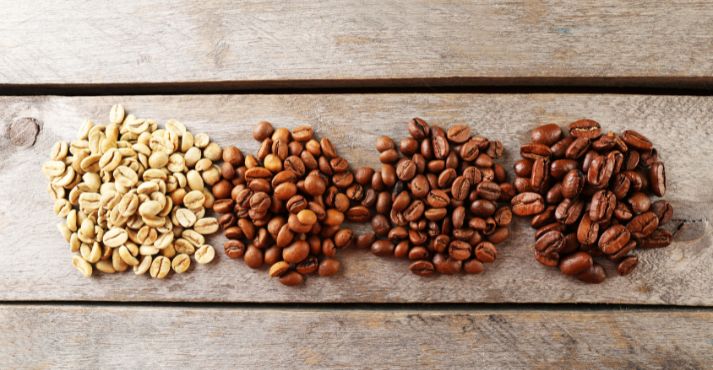
Despite the different flavors and varieties, there are only two coffee types: Arabica and Robusta, the two main commercially grown and sold coffee beans.
Coffee beans come from tropical regions near the equator called the Coffee Belt. The two main types of coffee beans, Arabica and Robusta, have distinct growing preferences and unique flavors.
1. Arabica
Arabica beans are often considered superior in taste and dominate the specialty coffee market. Arabica beans are a single-origin coffee known for their flavors and grow at higher elevations.
An Arabica shrub grows up to 15 feet (5m) tall but is usually pruned to about 6 feet (2m) to make it more commercially viable.
Despite containing less caffeine than Robusta, Arabica tends to have a smooth, mild acidity and notes of fruit. Blends often feature Arabica for a well-balanced and aromatic cup.
- Growing Regions: Arabica beans are grown at higher altitudes in regions with cooler temperatures. Key Arabica-producing countries include Ethiopia, Colombia, Brazil, Costa Rica, and Kenya.
- Flavor Profile: Arabica beans are renowned for their complex flavors, including fruit notes, floral tones, and mild acidity.
2. Robusta
Robusta coffee beans are resilient, high in caffeine, and grow in low-altitude regions. Robusta is a stouter plant about twice the size of Arabica and grows well in higher humidity.
Robusta’s bold, earthy taste with a hint of bitterness makes it ideal for espresso blends, adding depth and an intense kick to the cup. It is an excellent option for those who prefer intense flavors in their morning cup.
- Growing Regions: Robusta beans are typically grown in lower-altitude areas with warmer temperatures. Major Robusta-producing countries include Vietnam, Brazil, Indonesia, and parts of Africa.
- Flavor Profile: Robusta beans are known for their bold, earthy taste, higher caffeine content, and a hint of bitterness. They are often used to add depth to espresso blends.
3. Liberica
Liberica coffee beans, originating from West Africa, are known for their unique taste profile and larger size compared to other varieties. These beans thrive in warm climates and are often grown in regions with high humidity.
- Growing Regions: Liberica beans flourish in regions with warm climates and ample rainfall. They are predominantly cultivated in countries such as Liberia, Ivory Coast, and the Philippines, where the conditions are favorable for their growth.
- Flavor Profile: Liberica beans offer a unique and sometimes fruity taste, distinct from other coffee varieties. They are known for their bold flavor with hints of floral and fruity notes, making them a distinctive choice for coffee enthusiasts seeking something different. Liberica beans can add complexity and richness to coffee blends, contributing to diverse flavor profiles.
4. Excelsa
Excelsa coffee beans, originating primarily from Southeast Asia, are renowned for their distinctive and complex flavor profile, often characterized by fruity and tart notes. These beans thrive in regions with warm climates and high altitudes, contributing to their unique taste.
- Growing Regions: Excelsa beans are predominantly cultivated in countries such as the Philippines and Indonesia, where the climate and altitude provide optimal conditions for their growth.
- Flavor Profile: Excelsa beans offer a complex and fruity flavor profile with hints of tartness and a unique aroma. They are prized for their ability to add depth and complexity to coffee blends, making them a favored choice among enthusiasts seeking adventurous flavors.
Types of Hot Coffee Drinks
Hot coffee drinks cover a wide range of worldwide beverages, each offering its unique flavor profile and brewing method. Typically brewed with hot water and coffee grounds, these drinks vary in strength, sweetness, and texture, catering to different preferences and occasions.
From the bold intensity of espresso to the creamy richness of a latte, hot coffee drinks provide a comforting and refreshing experience, making them a beloved staple in cafes and households globally. Now, let’s explore the various types of hot coffee drinks to understand their characteristics and appeal.
1. Americano
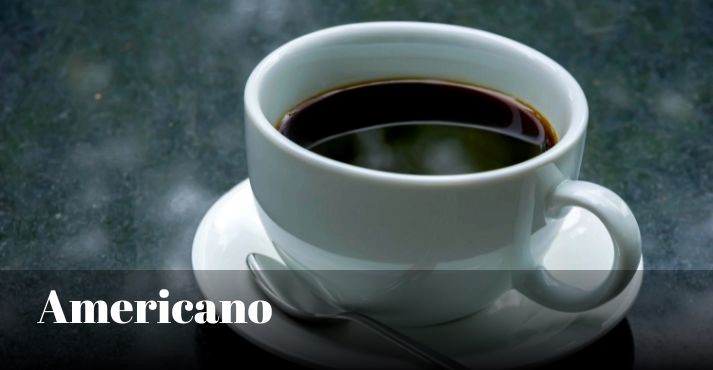
The Americano is one of the best types of coffee known for its simplicity and intense flavor. It originated during World War II when American soldiers stationed in Italy diluted their espresso with hot water, as they wanted something resembling the black Coffee they used to drink.
A caffè Americano is an espresso topped with hot water and can be made in several ways. You can find an Americano at almost any cafe in America and worldwide.
An Americano usually smells good, even more than regular coffee. This brewing technique involves adding hot water to a shot of espresso, resulting in a milder, larger beverage. A higher concentration of caffeine in the coffee gives the Americano a fuller-bodied texture and a richer taste.
2. Black Coffee
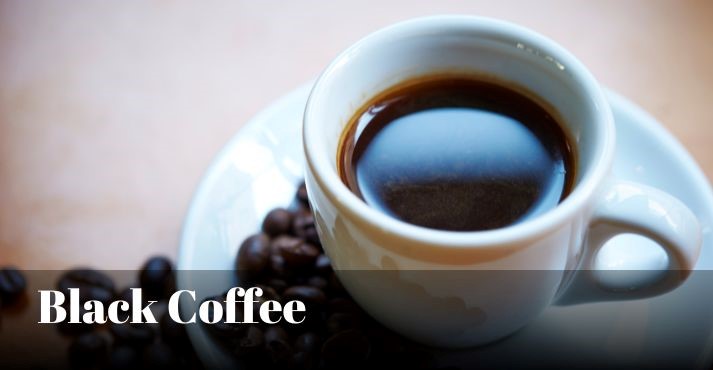
The name “Black Coffee” reflects its uncomplicated nature and the absence of ingredients that would alter its color. Black coffee heritage dates back to ancient centuries and forests on the Ethiopian plateau.
Black coffee is a simple yet classic preparation made by brewing coffee without added ingredients like milk or sugar.
Health benefits of black coffee
- Reduces weight
- Improves physical performance
- Decreases risk of diabetes
- Improves live health
- Boosts memory
The brewing technique involves pouring hot water over coarsely ground coffee beans through drip brewing, pour-over, or French press.
3. Black Eye

The name “Black Eye” originates from the intense impact this coffee blend has on energy levels, as it doubles down on espresso. Black Eye Coffee, also known as a “depth charge,” is a beverage made by adding a shot of espresso to a regular drip-brewed coffee.
Black Eye coffee is called a Sling Blade, Hammerhead, Autobahn, Shot Put, Shot in the Dark, and Café Tobio. It rivals energy drinks with around 224mg of caffeine in an 8 oz cup.
The brewing technique involves combining freshly brewed coffee with a shot of espresso, resulting in a beverage with a heightened caffeine content and a robust and bold flavor profile.
This powerful combination offers a caffeinated jolt, making it a popular choice for those seeking an intense coffee experience.
4. Bulletproof Coffee
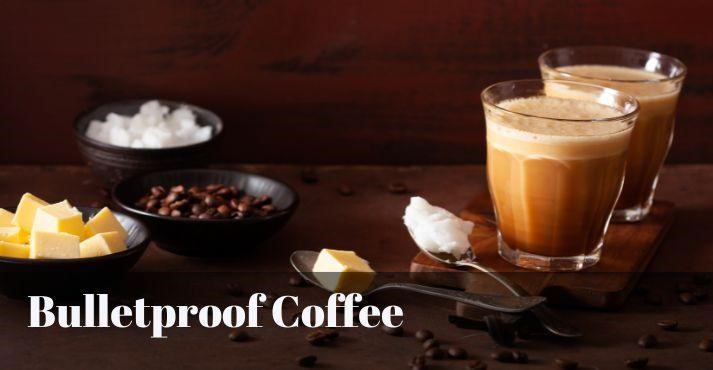
Bulletproof coffee is a trendy beverage known for its unique ingredients and potential health benefits. It’s made by blending high-quality coffee with grass-fed butter and MCT (medium-chain triglyceride) oil.
The concept behind bulletproof coffee is to provide sustained energy and mental clarity throughout the day. Grass-fed butter adds richness and creaminess to the coffee while providing essential fats. MCT oil, derived from coconut oil, contains medium-chain triglycerides rapidly converted into energy by the body.
Together, these ingredients create a frothy and indulgent coffee drink with a smooth texture and satisfying flavor. Bulletproof coffee enthusiasts claim it helps boost cognitive function, promote weight loss, and increase energy levels. However, consuming it in moderation and as part of a balanced diet is essential to reap its potential benefits.
5. Café au Lait
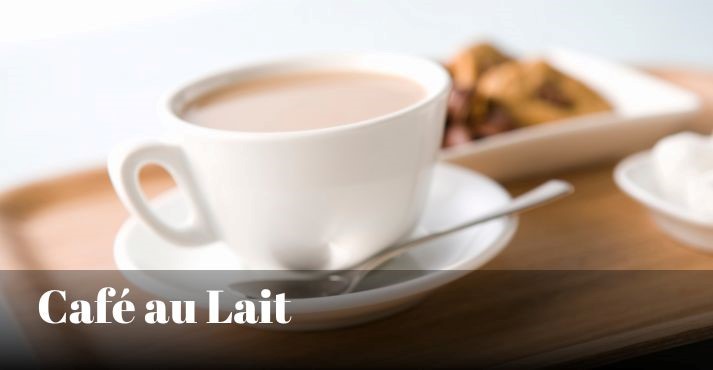
Café au lait is a coffee beverage from France, made with equal parts of strong, hot coffee and steamed milk. The name “Café au Lait” is French for “coffee with milk,” straightforwardly emphasizing its main ingredients.
Café au Lait is commonly consumed in the morning and is famous in French cafes and households. The brewing technique involves preparing a robust drip of coffee and then blending it with an equal amount of milk that has been steamed to create a creamy texture.
The result is a well-balanced beverage with the richness of coffee complemented by the smoothness of steamed milk.
6. Cappuccino
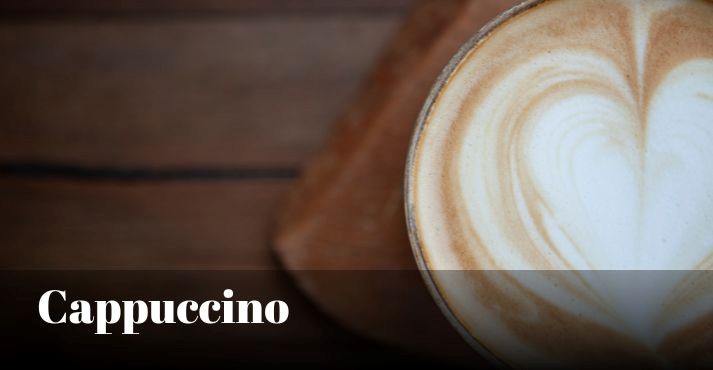
Cappuccino was created in Italy as far back as the 17th century – almost 400 years ago. Italian cappuccinos were served in small, preheated porcelain cups with a 1:1:1 ratio of a single shot (or double shot) of espresso with steamed milk and milk foam.
The name “Cappuccino” is inspired by the Capuchin friars’ brown robes, resembling the coffee’s color when mixing espresso and milk.
A cappuccino is a milk and coffee drink made using an espresso machine. The brewing process begins with a shot of espresso (25 milliliters of espresso coffee), followed by equal parts of steamed milk foam (100 milliliters of steam-foamed milk).
This meticulous layering creates a well-balanced and creamy texture, harmonizing the distinct flavors of espresso and milk.
Types of cappuccino:
- Wet Cappuccino – More creamy and mild in flavor
- Dry Cappuccino: Stronger flavor due to the difference in the milk-to-espresso ratio
- Iced Cappuccino: Cold milk foam is added on top
Cappuccinos are commonly savored in the morning or as an afternoon indulgence in cafes worldwide. The artful presentation of the foam atop the espresso is often enhanced with decorative designs, enhancing the sensory experience of this iconic coffee classic.
7. Cortado
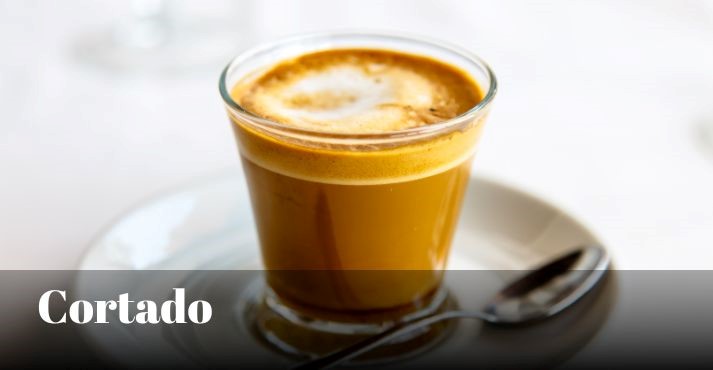
“Cortado” comes from the Spanish word “cortar,” meaning to cut, highlighting the beverage’s composition of cutting the strong espresso with milk.
Cortados are typically enjoyed in the morning or as an afternoon pick-me-up, appreciated for their strong coffee taste without the overwhelming nature of straight espresso.
Cortado is a Spanish-inspired and newcomer coffee beverage that artfully combines equal parts of espresso and warm milk, creating a balanced and flavorful drink.
The brewing technique involves pouring a shot of espresso and “cutting” it with an equal amount of steamed milk, resulting in a small yet potent coffee offering.
Commonly found in cafes, Cortados are served in small glasses, allowing coffee drinkers to savor the flavors in a compact and satisfying form.
8. Doppio
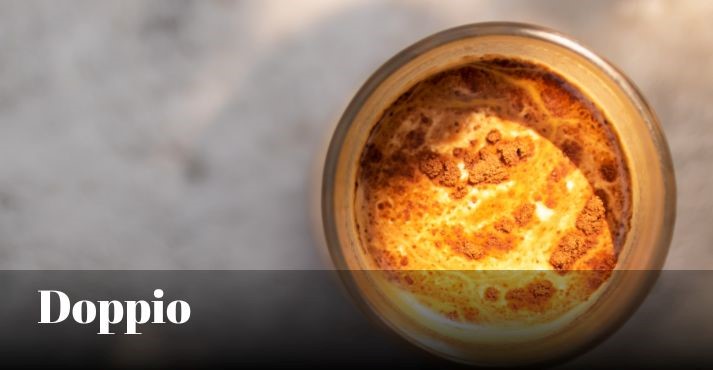
Doppio coffee, an Italian term for “double,” is a potent and concentrated espresso beverage. The name “Doppio” reflects the doubling of the espresso shot, emphasizing the increased strength and caffeine content.
The brewing technique involves extracting a double shot of espresso by passing hot water through finely-ground coffee beans under high pressure. This process results in a small yet potent coffee serving. They are favored by those who appreciate a more flavorful coffee experience.
Doppio coffee boasts an intense flavor profile, featuring the full-bodied richness of the coffee beans and a layer of crema on top.
9. Drip Coffee
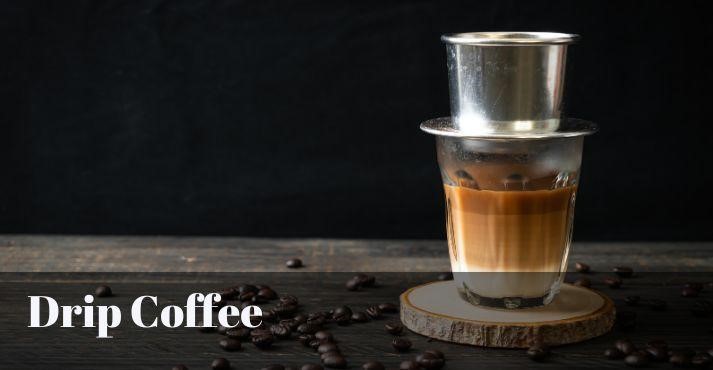
Drip coffee is a beloved way of brewing coffee that many people enjoy. Here’s how it works: first, you place a paper filter in a unique basket. Then, you add ground coffee to the filter. Next, you pour hot water over the coffee grounds. As the water drips through the grounds and filters, it picks up all the delicious flavors and aromas.
The brewed coffee then drips into a pot or carafe below. Drip coffee makers come in different sizes, from small ones for home use to large ones for cafes.
It’s a simple and efficient way to make a fresh coffee pot for yourself or share it with friends and family. Plus, you can customize the strength of your coffee by adjusting the amount of coffee grounds and water you use.
10. Espresso
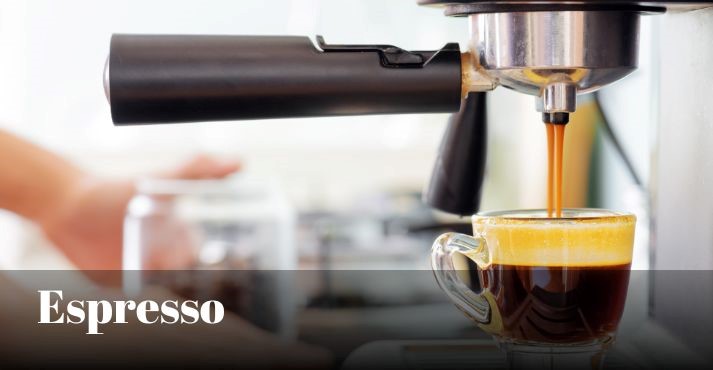
Espresso, originating from Italy, is a concentrated coffee. The name “espresso” comes from the Italian word for “pressed” or “expressed,” reflecting the quick brewing process. Espresso is made by forcing high-pressured hot water through finely-ground coffee beans.
Espresso is popular in cafes and homes worldwide, providing a quick and bold coffee experience for those seeking a solid and flavorful pick-me-up.
Fast facts about espresso:
- Origin: Italy
- Temperature: 190°F
- Caffeine: 29-100 mg per shot
- Primary Ingredient: ground coffee beans
A full-bodied, intense taste with a layer of rich crema characterizes the espresso flavor profile. Its concentrated nature allows the unique flavors of the coffee beans to shine, often delivering sweetness, bitterness, and acidity.
It is commonly consumed as a standalone shot or added to various coffee creations. For example, you can make several popular coffee drinks using Espresso:
- Caffé Americano: A shot of espresso combined with hot water
- Red-eye: Filtered coffee combined with one shot of espresso
- Caffé latte: A double shot of espresso topped with steamed milk
- Cappuccino: A single shot of espresso topped withteamed and frothed milk
Sipping it black is the quickest and most straightforward way to enjoy es spresso. There’s no need for frothy milk or flavored syrups – black espresso is a classic choice.
11. Espresso con Panna
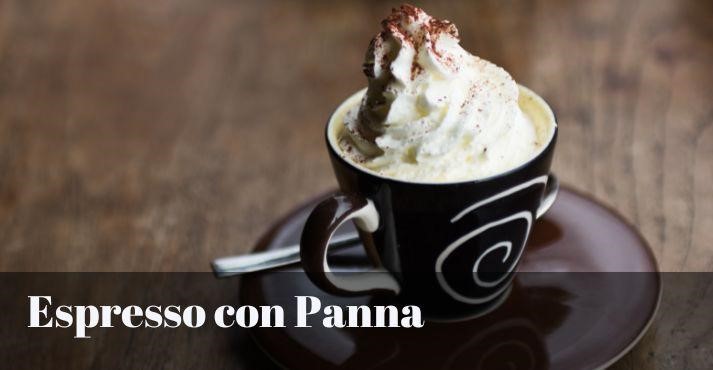
Espresso con Panna is a delightful coffee treat from Italy. It consists of a single espresso shot topped with freshly whipped cream. The name “con Panna” means “with cream” in Italian, reflecting the addition of this creamy topping to the strong espresso shot.
To prepare Espresso con Panna, start by pulling a shot of espresso using an espresso machine. Then, whip up some fresh cream until it forms soft peaks. Gently spoon the whipped cream onto the surface of the espresso shot.
The rich and velvety texture of the whipped cream adds a luxurious touch to the intense flavor of the espresso, creating a delightful contrast that will satisfy coffee lovers.
12. Flat White

Flat white has been around Australia and New Zealand since the 1980s when it was introduced as a balance between an intense espresso and a milky latte. In the early 2000s, it quickly became a staple in cafes worldwide.
The name “Flat White” emphasizes the smooth, velvety microfoam that gives the coffee a flat appearance compared to the thicker foam layer in a cappuccino. It balances the strong flavor of espresso and the creamy texture of milk.
A flat white is prepared in a 200-220ml ceramic cup with a 30ml shot of espresso and then topped with steamed milk. A flat white coffee tastes like a milder and creamier espresso, with a silky mouthfeel.
13. Galão Coffee
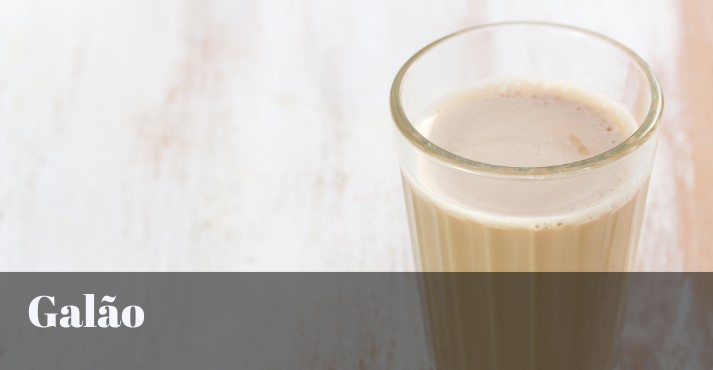
Originating from Portugal, the Galão is like a latte with a unique twist. To make it, you start with a shot of espresso in a tall glass. Then, you add lots of steamed milk. This creates a creamy and smooth drink that mixes the strong espresso flavor with the comforting taste of milk.
People enjoy Galão in the morning, or anytime they want a cozy drink. Because of its delicious and comforting flavor, it’s become popular in many places beyond Portugal. Whether you’re sitting in a café or on the move, Galão is a tasty treat for anyone who loves coffee.
14. Irish Coffee
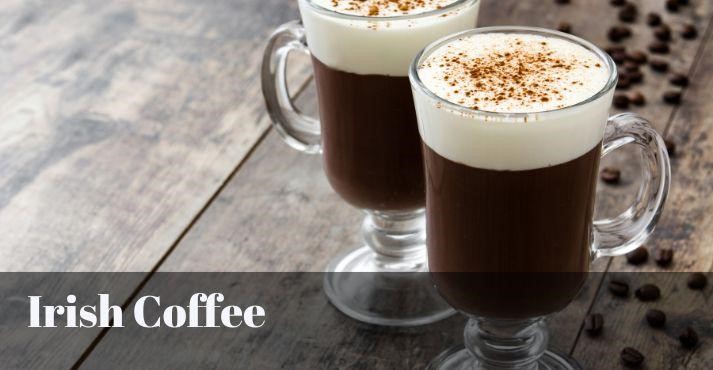
Irish Coffee is a classic cocktail with a rich history and a delightful flavor. It originated from Ireland in the 1940s and was created to warm up passengers arriving at the Foynes port after a long flight. The traditional recipe includes hot coffee, Irish whiskey, sugar, and a layer of cream floating on top.
To make it, start by brewing a strong cup of coffee and adding a shot of Irish whiskey and sugar to taste. Stir well to dissolve the sugar. Then, gently pour fresh cream over the back of a spoon to float it on top of the coffee without mixing.
The result is a comforting and decadent beverage with a perfect balance of warmth, sweetness, and richness. Irish Coffee is enjoyed worldwide as a cozy treat, especially during colder months.
15. Latte
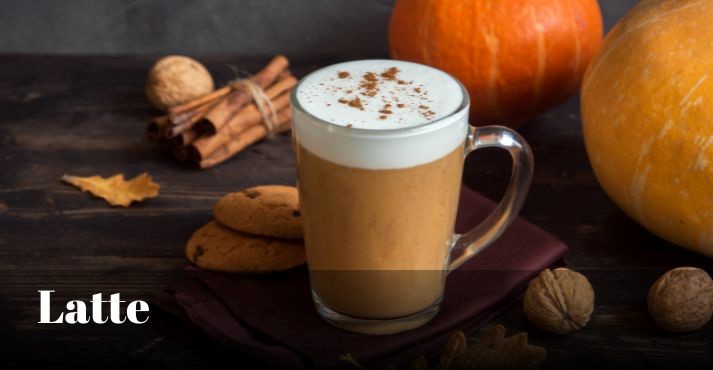
A Latte, short for caffè latte in Italian, is a popular espresso-based drink created by combining a shot of espresso with steamed milk and a small amount of foam. Lattes are often enjoyed in cafes and coffee shops as a morning pick-me-up and a comforting afternoon treat.
The name “Latte” is derived from the Italian word for milk, emphasizing the role of milk in this coffee creation. Lattes offer a more subdued coffee flavor than other espresso drinks, making them accessible to a wide range of palates.
The brewing process involves pulling a shot of espresso and then incorporating steamed milk, typically in a 1:2 ratio of espresso to milk. The result is a creamy, mildly sweet beverage with a smooth, velvety texture.
16. Long Black
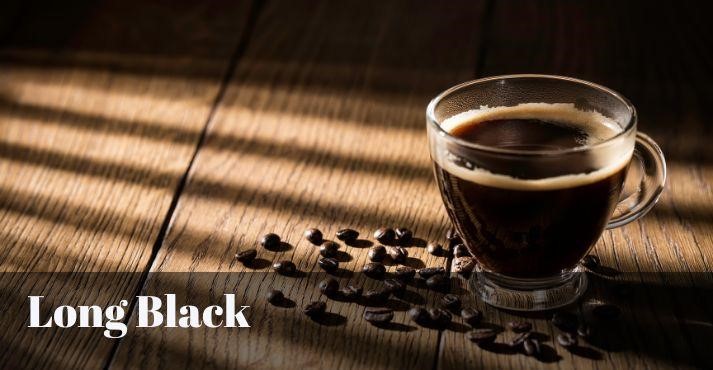
The Long Black is a popular coffee drink from Australia and New Zealand. Here’s how it’s made: first, a double shot of espresso is poured into a cup. Then, hot water is added to the espresso, filling the cup.
The key to making a perfect Long Black is carefully pouring the water over the espresso to retain its crema and intense flavor. Unlike an Americano, where water is added to the espresso, the Long Black preserves the rich taste of the espresso while diluting it slightly for a smoother finish.
This method ensures the coffee maintains its bold flavor profile while providing a more extended and milder coffee experience. The Long Black is cherished for its strong yet balanced taste, making it a favorite among coffee enthusiasts in the southern hemisphere and beyond.
17. Lungo
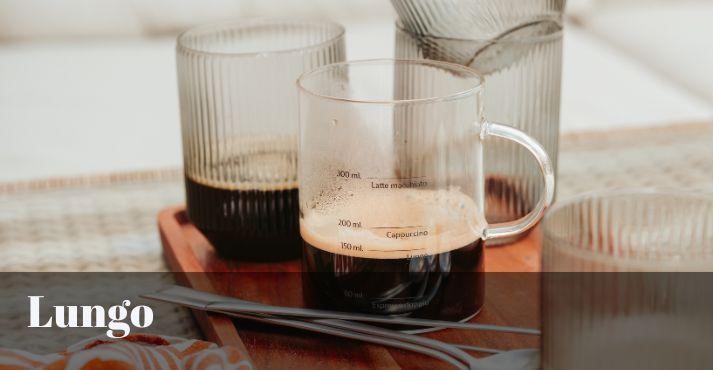
Lungo, an espresso variation, is created by pulling a more extended espresso than a standard espresso shot. The name “Lungo” is derived from the Italian word for “long,” emphasizing the extended brewing time.
During the brewing process, hot water flows through finely ground coffee for a more extended period, resulting in a coffee with more volume than a typical espresso shot. This process extracts more flavor compounds, giving a milder taste with a distinct aroma.
A Lungo offers a balanced and flavorful option for coffee enthusiasts seeking a more extended and smoother coffee experience. While it maintains the intensity of espresso, the extended brewing time reduces its strength and bitterness, resulting in a more nuanced flavor profile. Lungo is commonly enjoyed in cafes and at home, providing a satisfying and aromatic coffee indulgence.
18. Macchiato
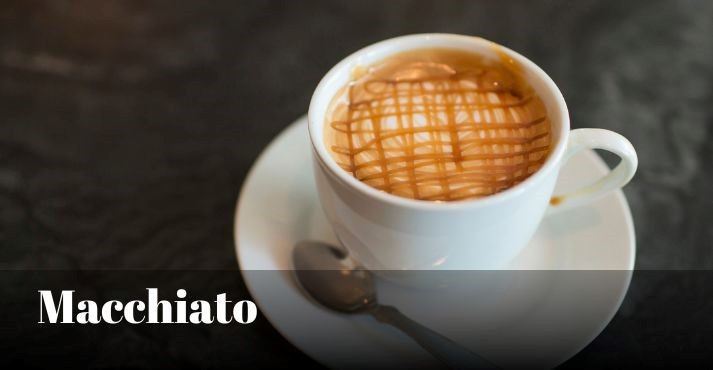
A Macchiato, meaning “stained” or “spotted” in Italian, is a coffee characterized by simplicity and bold flavor. The name reflects its preparation, as the espresso is “stained” or marked by the milk.
Macchiatos are commonly consumed as a quick, flavorful pick-me-up and are prevalent in coffee shops worldwide.
A Macchiato has less milk than other coffee drinks, almost like espresso. Made by adding a shot of espresso to a small amount of frothy milk, the Macchiato balances the intensity of espresso with a hint of creaminess.
Macchiato tastes like coffee beans, with a bit of softness from the milk. You might taste the foam and coffee separately if the foam is on top.
There are two types of macchiato drinks: plain macchiato and espresso macchiato. The plain macchiato is typically served in a tall glass and topped with milk foam; the second is the espresso macchiato, served in a small cup and often has a milk foam-topping or latte art.
19. Mocha
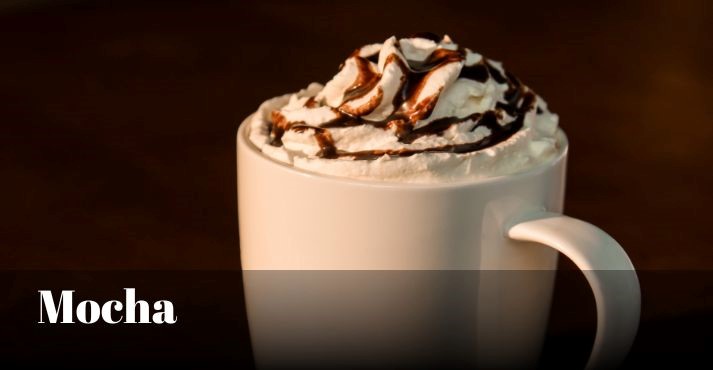
Mocha was initially named after the mocha bean, a coffee bean shipped from the port of Al Mokka in Yemen. Mocha coffee is a delightful and indulgent beverage that combines espresso, steamed milk, and chocolate.
The brewing process begins with a shot of espresso, followed by the addition of steamed milk and a generous serving of chocolate syrup or cocoa powder.
This combination results in a rich and decadent flavor profile, where espresso melds with chocolate’s sweetness and steamed milk’s creamy texture.
Types of mocha coffee
- Original Mocha
- White Mocha
- Iced Mocha
- Hazelnut Mocha
- Caramel Mocha
- Dark Chocolate Mocha
- Marble Mocha
Mochas are often a comforting and dessert-like treat in specialty coffee shops and at home. Whipped cream and chocolate shavings or syrup are standard toppings, adding an extra layer of indulgence to this popular coffee concoction.
20. Red Eye
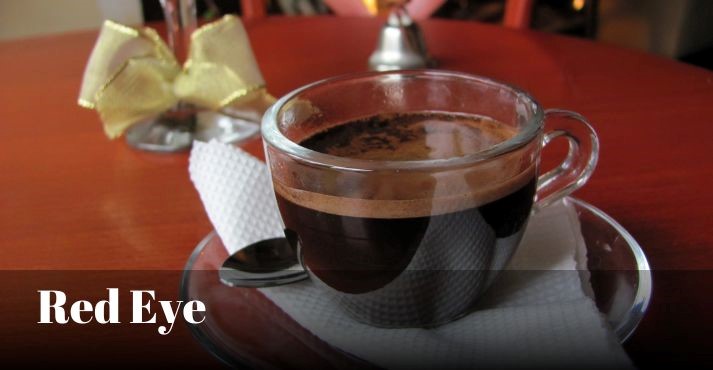
A red-eye coffee also called a “shot in the dark,” consists of a regular brewed coffee with an espresso shot. The name “Red Eye” is thought to reflect the tired or bloodshot eyes of someone needing a solid caffeine boost.
The red eye is named after a red-eye flight, famously a middle-of-the-night flight from the West Coast to New York City. The term may also signify the reddish hue of the coffee when espresso is added.
The brewing technique involves adding a freshly pulled shot of espresso to a cup of hot brewed coffee. This infusion enhances the overall strength and caffeine content, providing a robust and flavorful punch.
A classic red eye is made with one shot of espresso, which contains approximately 100 milligrams of caffeine. This coffee blend is often consumed in the morning or as a midday pick-me-up, offering a bold and energizing experience.
21. Ristretto
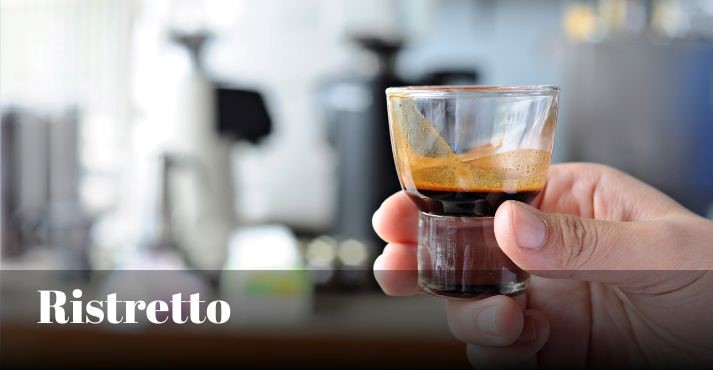
The ristretto originated in the early 20th century and is believed to be the original espresso. In Italian, “Ristretto” means “restricted.” When talking about coffee, a ristretto is a short espresso shot. This means the barista only uses the first part of a regular espresso shot, making it stronger.
Its brewing technique involves using less water than a standard espresso shot with the same amount of finely-ground coffee, resulting in a shorter and more potent extraction.
Ristretto coffee offers a full-bodied flavor profile with a reduced volume, appealing to those who appreciate a more concentrated and intense coffee experience.
The shorter extraction time showcases the pure essence of the coffee, making it a preferred choice for espresso enthusiasts seeking a rich and intense coffee flavor.
22. Turkish Coffee
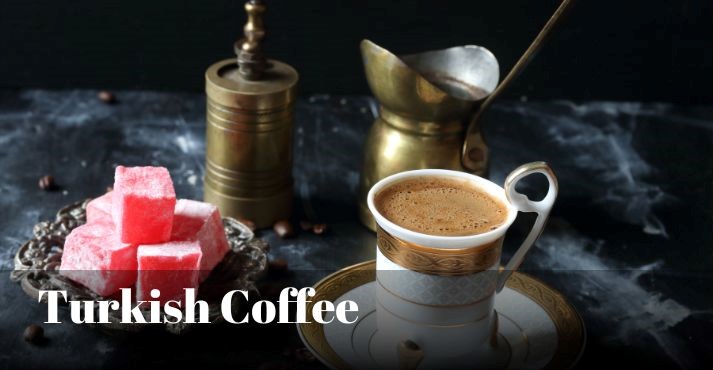
The name “Turkish Coffee” originates from the Ottoman Empire. It’s often associated with a particular brewing style, a unique coffee pot, and a distinct serving method.
The Turkish coffee researchers believe it went from Ethiopia to the rest of the world. It was brought to Istanbul by the governor of Yemen in 1517.
Turkish Coffee is a traditional brewing method that simmers finely ground coffee beans with water and sugar (optional) in a unique pot called a cezve. The brewing technique focuses on creating a robust and unfiltered coffee with grounds settling at the bottom.
Turkish Coffee is usually enjoyed in small cups without milk, accompanied by a glass of water to cleanse the palate.
The flavor profile of Turkish Coffee is rich and often intense due to the fine grind and prolonged simmering process. The result is a thick, aromatic coffee with a unique, sludgy texture.
Types of Cold Coffee Drinks
Cold coffee drinks are a refreshing option, especially during warmer weather, or as a refreshing pick-me-up any day. They are typically made by brewing coffee and then chilling it by refrigeration or adding ice.
From classic favorites like iced coffee to innovative creations like nitro coffee, there’s a cold coffee drink to suit every taste preference and occasion. Now, let’s explore some popular types of cold coffee drinks in more detail.
23. Affogato
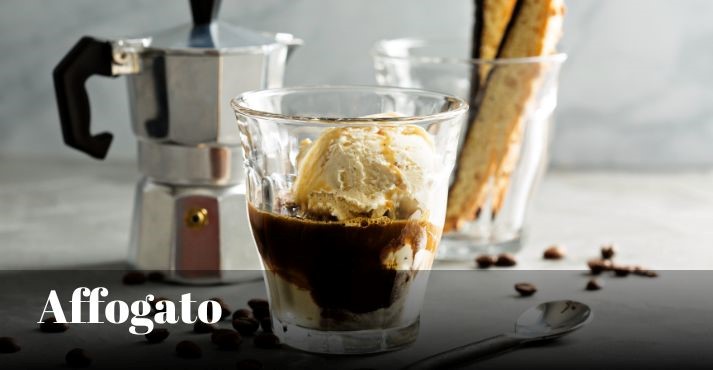
The name “Affogato” translates to “drowned” in Italian, signifying the act of drowning the ice cream in the rich and aromatic espresso. The origins of the affogato in Italian history are still being determined, but it gained popularity in Italy during the 1950s.
This unique combination results in a delightful contrast of bitter and sweet flavors, making it a popular choice for those who enjoy a dessert-like coffee experience.
Affogato, an Italian delight, is a simple and indulgent coffee-based dessert. The brewing technique involves pouring a shot of hot espresso over a scoop of vanilla ice cream or gelato.
The hot espresso melts the ice cream, blending contrasting temperatures and textures. Affogatos are typically consumed as a dessert or treat, often enjoyed in cafes or restaurants after a meal.
24. Cold Brew
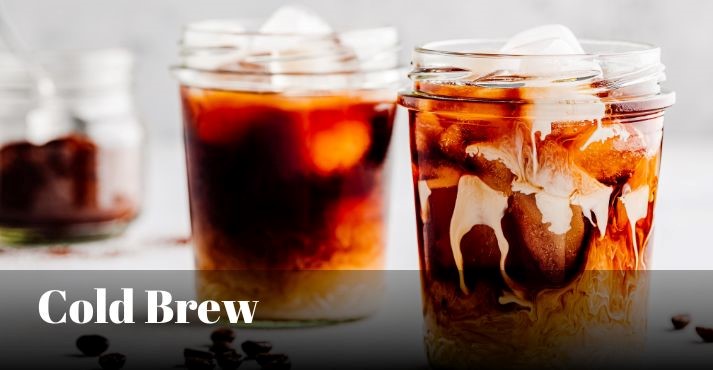
Cold brew coffee has gained popularity among coffee drinkers in recent years. According to the National Coffee Association, cold brewing is the third most popular method of preparing coffee. Cold-brew coffee has a rich history; the first evidence of cold brew made with cold water comes from Japan.
The process of making cold brew is unique. What makes cold brew coffee so delicious is the time it takes to brew. Cold Brew is a coffee preparation method that involves steeping coarsely ground coffee beans in cold water for an extended period, typically 12 to 24 hours.
Cold brews are less acidic than regular coffee. Less acidic cups of coffee happen because cold water pulls out less acid in coffee than hot water.
This slow extraction process produces a coffee concentrate diluted with water or milk before serving. Unlike traditional brewing methods, Cold Brew avoids heat, resulting in a smoother, less acidic flavor profile with subtle, natural sweetness.
25. Frappuccino

The name “Frappuccino” is a combination of “frappe,” a term for a blended iced drink, and “cappuccino,” indicating its coffee base. While Starbucks popularized the term, it has become synonymous with blended iced coffee drinks.
Frappuccinos are a cold and sweet treat, particularly popular in warm weather. They are available at coffee shops globally, providing a convenient option for on-the-go coffee enthusiasts.
The brewing technique combines coffee, milk, ice, and flavored syrups or sauces in a blender. The result is a smooth and slushy consistency, creating a refreshing and chilled coffee experience. Vanilla, mocha, and caramel are the most common flavors.
26. Iced Caramel Macchiato

Many love the iced caramel macchiato, a delightful and rich coffee beverage that combines the rich flavors of espresso with creamy milk and a sweet touch of caramel syrup.
This refreshing drink is typically served over ice, making it perfect for hot summer days or whenever you’re in the mood for a relaxed and satisfying treat.
The preparation involves layering cold milk over ice, followed by a shot of espresso, and then drizzling caramel syrup on top for that irresistible sweetness. With its perfect balance of coffee, milk, and caramel flavors, the iced caramel macchiato will surely delight your taste buds and provide a refreshing pick-me-up whenever needed.
27. Iced Latte
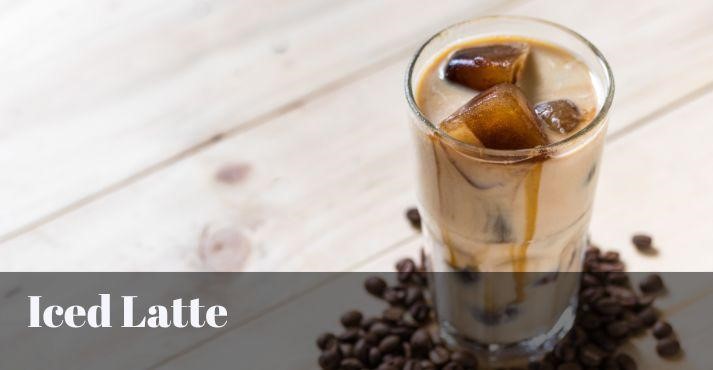
An iced latte is a delightful and refreshing coffee beverage perfect for warmer days or as an excellent pick-me-up. It’s crafted by pouring espresso over ice and then adding chilled milk. The espresso provides a bold and robust coffee flavor, while the milk adds a creamy and smooth texture.
The drink is typically served in a tall glass, allowing the layers of espresso, milk, and ice to blend beautifully. Iced lattes can be customized to suit individual preferences, with options to add flavored syrups or whipped cream for extra indulgence.
28. Mazagran

Mazagran is a delightful coffee drink that originated in Algeria. It’s a refreshing concoction made by combining cold coffee with ice and sweetening it with sugar. Sometimes, it’s flavored with a dash of lemon juice or a splash of rum for an extra kick.
The origins of Mazagran date back to the 19th century, when it gained popularity among French soldiers stationed in Algeria. They would mix their coffee with water to cool and sweeten it with sugar, creating a refreshing beverage perfect for hot climates.
Over time, Mazagran became a beloved drink across various cultures, enjoyed for its invigorating taste and ability to provide a refreshing burst of energy on warm days.
29. Nitro Coffee
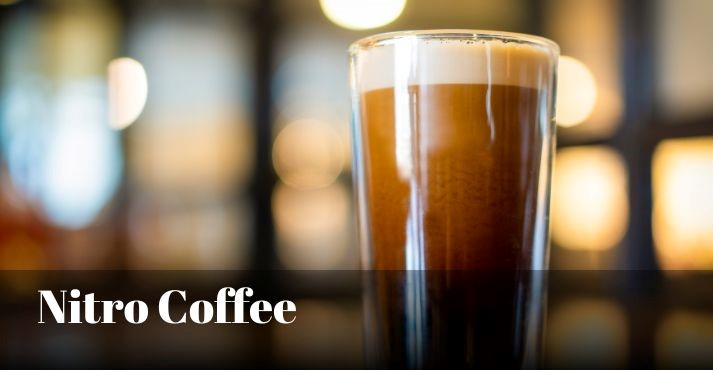
The name “Nitro” reflects nitrogen use in brewing, distinguishing it from traditional coffee preparations. Nitro coffee is often consumed straight from the tap, poured over ice, or even in cans for on-the-go enjoyment.
The drink’s invention can be credited to Portland-based food scientist Nate Armbrust, who created the frothy and mellow sensation while working at roasters.
Its popularity has grown in cafes and specialty coffee shops, offering a refreshing and unique alternative for coffee enthusiasts seeking a cold and velvety coffee experience.
Nitro Coffee has a creamy and slightly effervescent texture, enhancing the overall sensory experience. The nitrogen infusion mellows the acidity, resulting in a sweeter and less bitter flavor profile.
Nitro coffee is simply cold brew coffee infused with colorless and odorless nitrogen.
The brewing technique involves infusing cold brew coffee with nitrogen gas, typically served on tap. This creates a cascading effect and a creamy mouthfeel, imparting a distinctive, almost beer-like quality to the coffee.
30. Shakerato: Italian Iced Coffee
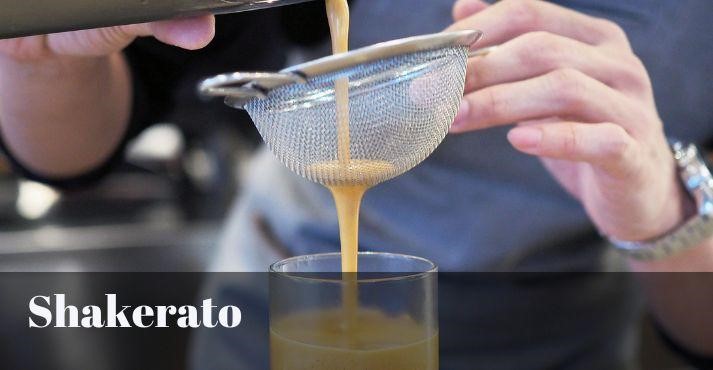
Shakerato, a delightful Italian coffee creation, is crafted by vigorously shaking freshly brewed espresso, ice, and sometimes sugar in a cocktail shaker. This process creates a bubbly and refreshing beverage that is served chilled.
The intense shaking action blends the ingredients, producing a smooth and refreshing coffee drink with a velvety texture. Shakerato is often enjoyed during the hot summer months in Italy as a cooling and revitalizing pick-me-up.
Its simplicity and elegance make it popular among coffee lovers seeking a sophisticated yet refreshing alternative to traditional hot espresso drinks.
31. Vietnamese Iced Coffee (Cà phê đá)
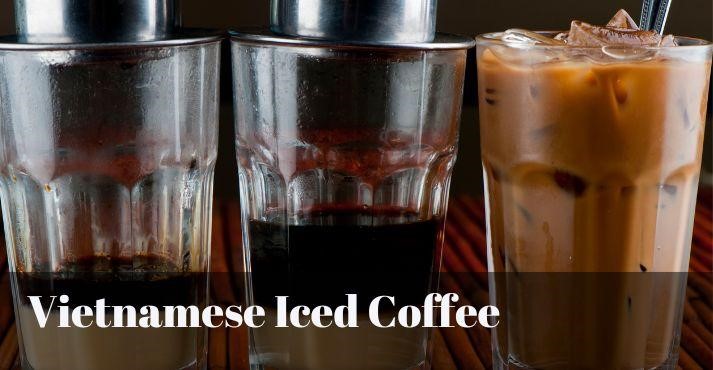
Vietnamese iced coffee, known as Cà phê đá, is a beloved beverage celebrated for its bold flavor and creamy sweetness. This refreshing drink is prepared by brewing strong coffee using a Vietnamese drip filter, which produces a rich and robust brew.
Once brewed, the coffee is poured over a generous amount of ice to chill it. Then, sweetened condensed milk is added to the coffee, giving it a creamy texture and a delightful sweetness that balances the strong coffee flavor. The result is a refreshing and indulgent drink perfect for cooling down on a hot day.
Frequently Asked Questions (FAQs)
What Is Coffee with Milk Called?
Coffee with milk is commonly called a latte. It combines espresso with steamed milk, creating a creamy and slightly sweet beverage.
Which Type of Coffee Is Sweet?
A type of coffee that is naturally sweet is a mocha. This delicious drink combines espresso with chocolate syrup, cocoa powder, and steamed milk, offering a rich and indulgent flavor with a hint of sweetness.
What Is Coffee Without Milk Called?
Coffee without milk is often referred to as black coffee or simply coffee. Its brewed coffee is served without any added milk or cream, allowing the full flavor of the coffee beans to shine through.
What Is the Strongest Coffee?
Due to its concentrated nature, the most robust coffee is typically considered espresso. Espresso is made by forcing hot water through finely ground coffee beans at high pressure, resulting in a small but potent shot of coffee.
Conclusion
From the simplicity of black coffee to the complexity of a Nitro brew, different kinds of coffee beverages have been part of human history for centuries.
Now that we have discussed 31 different types of coffee, you must be aware of the brewing techniques, flavor profiles, and origin, catering to diverse preferences. The names, often rooted in cultural or historical contexts, add a layer of richness to the coffee experience.













